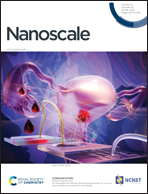A flexible tissue–carbon nanocoil–carbon nanotube-based humidity sensor with high performance and durability†
Abstract
A flexible humidity sensor based on a tissue–carbon nanocoil (CNC)–carbon nanotube (CNT) composite has been investigated. Taking advantage of the excellent water absorption of tissue and the electrical sensitivity of CNCs/CNTs to humidity, this humidity sensor obtains outstanding humidity sensing performance, including a wide sensing range of 10–90% RH, a maximum response value of 492% (ΔR/R0) at 90% RH, a maximum sensitivity of 6.16%/% RH, a good long-time stability of more than 7 days, a high humidity resolution accuracy of less than 1% RH and a fast response time of 275 ms. Furthermore, the sensor also exhibits robust bending (with a curvature of 0.322 cm−1) and folding (up to 500 times) durability, and after being made into a complex “thousand paper crane” shape it still provides stable humidity sensing performance. As a proof of concept, this humidity sensor demonstrates excellent responsivity to human breath monitoring, non-contact fingertip humidity detection, water boiling detection and air humidity monitoring, indicating great potential in the fields of wearable devices, weather forecasting systems and other intelligent humidity monitoring devices.



 Please wait while we load your content...
Please wait while we load your content...